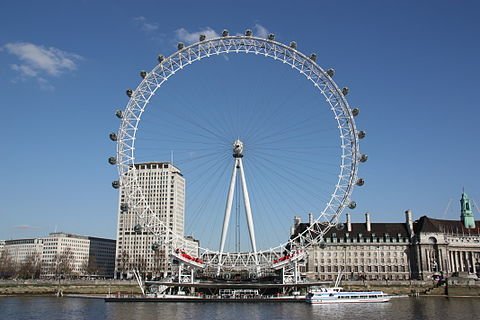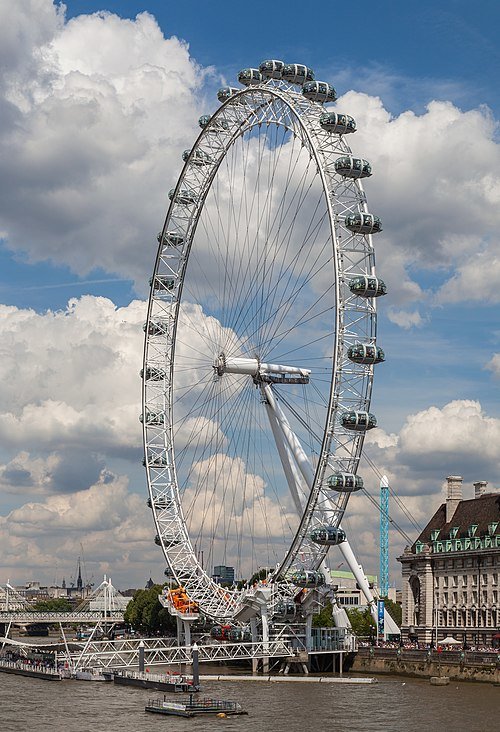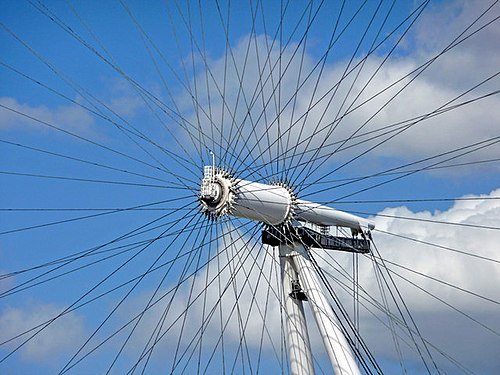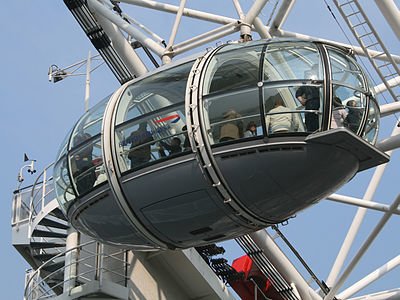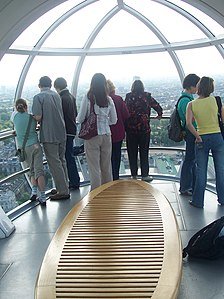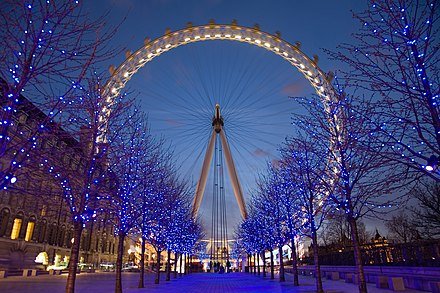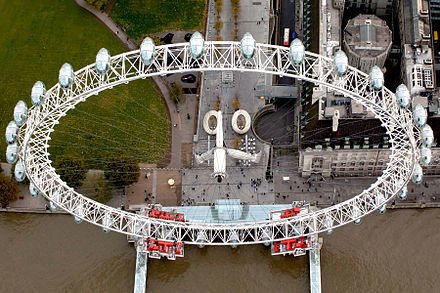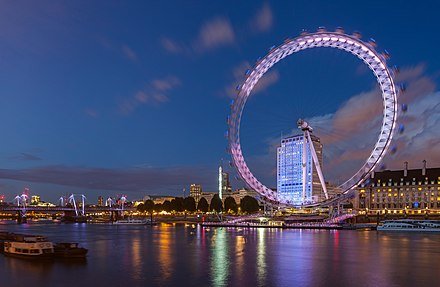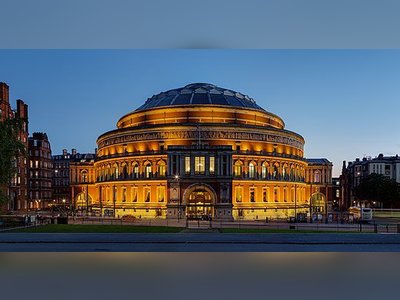British Heritage
Remember, Cherish, Learn.
beta
London Eye
A Salient Symbol of British Heritage.
The London Eye, colloquially known as the Millennium Wheel, stands majestically on the South Bank of the River Thames in London. Since its inception, it has become an enduring symbol of the city's skyline, an icon of British heritage, and a key contributor to the UK's tourism industry. By offering an unrivalled perspective of the city, the London Eye has brought a new dimension to how visitors experience London, making it not just a tourist attraction, but a significant part of British culture.
The London Eye, towering 135 metres high with a wheel diameter of 120 metres, is a marvel of modern architecture and engineering. It was the world's tallest cantilevered observation wheel when it opened to the public in 2000. Despite being surpassed in height by other observation wheels in the ensuing years, the London Eye's unique design - a magnificent A-frame that supports the wheel on one side - continues to distinguish it from its peers.
The London Eye's structure takes inspiration from a spoked bicycle wheel, with tensioned steel cables supporting the rim. A triumph of multinational collaboration, this monumental project involved major components sourced from six different countries. The wheel was constructed in sections, floated up the Thames on barges, and assembled on piled platforms in the river before being raised into its upright position.
The husband-and-wife team of Julia Barfield and David Marks of Marks Barfield Architects conceptualised the design of the London Eye. A host of companies, including Mace, Hollandia, and Tilbury Douglas, were instrumental in the wheel's construction, each contributing their expertise to this iconic project.
The London Eye was inaugurated by then Prime Minister Tony Blair on 31 December 1999, and opened to the public on 9 March 2000. Initially, it was proposed as a temporary attraction with a five-year lease. However, recognising its immense popularity and symbolic importance to London's cityscape, an application was made in 2001 to grant the London Eye permanent status, which was granted in July 2002.
Since its opening, the London Eye has captivated millions with its breathtaking views of London. As of 2008, the London Eye has had over 30 million riders, making it the most popular paid tourist attraction in the United Kingdom. The observation wheel features 32 sealed and air-conditioned passenger capsules, each of which can hold up to 25 people. The capsules offer an immersive, panoramic view of the city, making a full revolution in approximately 30 minutes.
The London Eye is more than just a monument or an observation wheel; it is an integral part of British cultural heritage. This status was exemplified in 2013 when a passenger capsule was named the Coronation Capsule to commemorate the sixtieth anniversary of Queen Elizabeth II's coronation. Over the years, the Eye has also made several appearances in popular culture, and it's common to see the wheel lit up in various colours to mark special occasions or causes.
The London Eye has changed hands multiple times since its inception. The original owners were Marks Barfield, The Tussauds Group, and British Airways. Tussauds acquired full ownership in 2006, before itself being bought by the Blackstone Group in 2007 and merged with Merlin Entertainments. Sponsorship has also evolved, with Coca-Cola and lastminute.com being notable sponsors.
The London Eye has been widely lauded for its architectural brilliance and its contribution to the city's tourism. Renowned architect Sir Richard Rogers likened its impact on London to the Eiffel Tower's impact on Paris, noting its importance as a public and accessible symbol of the city. Visitors and photographers alike commend the unparalleled photographic opportunities it provides, and the unique experience of observing London from its apex.
Visitors to the London Eye are well-served by multiple transport options. The nearest London Underground station is Waterloo, with Charing Cross, Embankment, and Westminster also within walking distance. National Rail services connect at London Waterloo station and London Waterloo East station. Additionally, London River Services operated by Thames Clippers and City Cruises stop at the London Eye Pier.
In conclusion, the London Eye has left an indelible mark on British heritage. Its unique design, impressive stature, and the experience it offers have made it a beloved symbol of London, playing a significant role in shaping the city's identity.
Structural Brilliance
The London Eye, towering 135 metres high with a wheel diameter of 120 metres, is a marvel of modern architecture and engineering. It was the world's tallest cantilevered observation wheel when it opened to the public in 2000. Despite being surpassed in height by other observation wheels in the ensuing years, the London Eye's unique design - a magnificent A-frame that supports the wheel on one side - continues to distinguish it from its peers.
The London Eye's structure takes inspiration from a spoked bicycle wheel, with tensioned steel cables supporting the rim. A triumph of multinational collaboration, this monumental project involved major components sourced from six different countries. The wheel was constructed in sections, floated up the Thames on barges, and assembled on piled platforms in the river before being raised into its upright position.
The husband-and-wife team of Julia Barfield and David Marks of Marks Barfield Architects conceptualised the design of the London Eye. A host of companies, including Mace, Hollandia, and Tilbury Douglas, were instrumental in the wheel's construction, each contributing their expertise to this iconic project.
The Vision and Its Realisation
The London Eye was inaugurated by then Prime Minister Tony Blair on 31 December 1999, and opened to the public on 9 March 2000. Initially, it was proposed as a temporary attraction with a five-year lease. However, recognising its immense popularity and symbolic importance to London's cityscape, an application was made in 2001 to grant the London Eye permanent status, which was granted in July 2002.
Since its opening, the London Eye has captivated millions with its breathtaking views of London. As of 2008, the London Eye has had over 30 million riders, making it the most popular paid tourist attraction in the United Kingdom. The observation wheel features 32 sealed and air-conditioned passenger capsules, each of which can hold up to 25 people. The capsules offer an immersive, panoramic view of the city, making a full revolution in approximately 30 minutes.
An Iconic Cultural Fixture
The London Eye is more than just a monument or an observation wheel; it is an integral part of British cultural heritage. This status was exemplified in 2013 when a passenger capsule was named the Coronation Capsule to commemorate the sixtieth anniversary of Queen Elizabeth II's coronation. Over the years, the Eye has also made several appearances in popular culture, and it's common to see the wheel lit up in various colours to mark special occasions or causes.
Ownership and Sponsorship
The London Eye has changed hands multiple times since its inception. The original owners were Marks Barfield, The Tussauds Group, and British Airways. Tussauds acquired full ownership in 2006, before itself being bought by the Blackstone Group in 2007 and merged with Merlin Entertainments. Sponsorship has also evolved, with Coca-Cola and lastminute.com being notable sponsors.
Reception and Significance
The London Eye has been widely lauded for its architectural brilliance and its contribution to the city's tourism. Renowned architect Sir Richard Rogers likened its impact on London to the Eiffel Tower's impact on Paris, noting its importance as a public and accessible symbol of the city. Visitors and photographers alike commend the unparalleled photographic opportunities it provides, and the unique experience of observing London from its apex.
Transport Links
Visitors to the London Eye are well-served by multiple transport options. The nearest London Underground station is Waterloo, with Charing Cross, Embankment, and Westminster also within walking distance. National Rail services connect at London Waterloo station and London Waterloo East station. Additionally, London River Services operated by Thames Clippers and City Cruises stop at the London Eye Pier.
In conclusion, the London Eye has left an indelible mark on British heritage. Its unique design, impressive stature, and the experience it offers have made it a beloved symbol of London, playing a significant role in shaping the city's identity.
- London Eyeen.wikipedia.org
